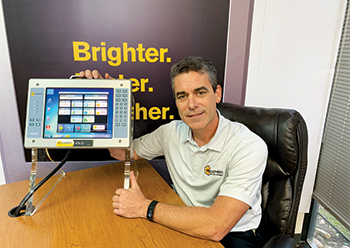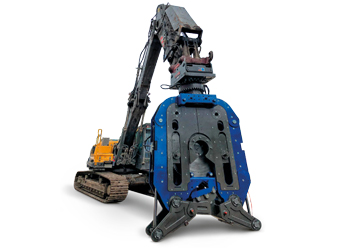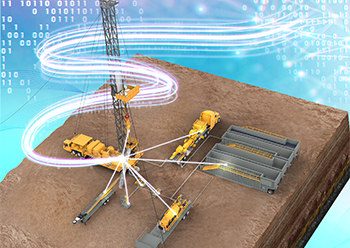
 Figure 1: Decom Chopsaw excavator mounted for decommissioning a quiksilver gas pipeline
Figure 1: Decom Chopsaw excavator mounted for decommissioning a quiksilver gas pipeline
With 7,500 km of pipelines to be decommissioned over the next 10 years in the UK and Norway alone, there has never been a better time to explore how these pipelines can be removed and recycled in a way that minimises carbon footprints and encourages the re-use of such high quality steel tubulars.
Since its establishment in 2011, this has been the core mission of Decom Engineering: Developing innovative solutions for decommissioning that carry a positive environmental impact.
There are two aspects to this problem. Firstly, removing the pipelines in a way that is cost effective and which results in minimal damage thus allowing maximum potential for re-use; and then crucially, to find a valuable way to repurpose or recycle it.
CLEAN REMOVAL
One of the biggest challenges we have seen with the cutting of pipelines is the efficacy of cutting apparatus subsea and the ability to make multiple cuts on a single deployment. For example, if hydraulic shears are utilised then this means the pipe ends are crimped, making it harder to inspect, decontaminate and re-use or recycle.
Decom has developed a solution to avoid this: A single blade chopsaw with a tungsten carbide tipped (TCT) blade that can clamp through sediment and make a fast (32 minutes on 16 inches OD, 45 mm WT, L80 grade material), clean cut of the pipeline (see figure 1).
Using this method, Decom offers a solution that can be ROV, crane or excavator operated and makes a fast, clean cut through the pipeline whilst the versatile clamping system allows easy movement through various sizes without the need for retooling. Additionally, thanks to the longevity of a TCT blade, many cuts can be made before the need for re-tooling on the surface.
 |
Figure 2: A clean cut pipeline using a Decom chopsaw making |
If the material has concrete around it or other casings or materials to be cut, Decom then has an interchangeable cutting head and motor that can be swapped in and which utilises a vacuum brazed diamond blade in a high speed low torque setup. This is ideal if concrete or umbilicals in the vicinity of the pipeline need removal or repair during the decommissioning process.
With decommissioned pipe coming out in clean cut sections, internal probing and testing for decontamination work can continue unobstructed leaving coated pipe that is easily handled. The Decom chopsaw achieves this clean cut (figure 2) making inspection easier and safer.
Utilising the Decom Chopsaw for pipeline removal has a number of advantages:
• It can cut a range of sizes with one setup and be changed for size without coming out of the water. Figure 3 shows the subsea model with ROV handles.
• Safe clamping mechanism.
• Reverse cut mechanism to cut out of materials where needed.
• Interchangeable from solid metal cut types to umbilical style cuts by changing motor and blade type.
• Low consumable costs (10 to 30 cuts per blade, before a low sharpening or re-tipping cost compared with 1 to 2 cuts for a diamond wire).
• Comparable cut times.
• Smooth cut finish compared with shears which crimp the cut area thus enabling repairs.
Unfortunately a large barrier still remains; the original pipe coating.
COATING REMOVAL
As the scale of pipeline decommissioning increases, the question of what to do with coated pipeline that has lived its useful life in the ground or underwater is becoming ever more urgent.
A coated pipe may be able to be re-used as an agri-roller, but other options for resale are very limited. The increase in pipe supply, therefore, presents a real risk that decommissioning yards will be overrun with decommissioned pipe.
 |
|
Figure 3: Decom Coating Removal Machine giving pipe a new lease of life |
As the pipes cannot be effectively recycled with the coating on due to contamination of the process and so the only viable solution is to remove the coating. Existing solutions for this process are slow, costly, unsafe for operators, environmentally unfriendly and poor quality. These include excavator removal, water jets, simple lathes, and reverse heating.
Decom has provided an innovative solution to this problem by developing a pipe coating removal system (figure 3) that utilises a cold method to remove both coatings (FBE/PE) whilst avoiding any damage to the pipe. The machine has:
• A multi-tool station, typically 3-8 tools, which will process all pipe coated between 4 to 60 inches in diameter and 6-24 m in length. Average processing speed is 70 sq m per hour.
• A waste collection and disposal system using on-board dust extraction and collection conveyors for PE/PP.
• Achieved a pipe surface that is left 100 per cent clean of all coatings and welds can be NDT tested. The Decom machine can be easily installed anywhere in the world limiting the additional movement of decommissioned pipe as the carbon footprint of moving pipe more times than necessary far exceeds that of moving the machine. Additionally Decom is able to recycle the captured PE coatings to further improve the green lifecycle of the pipelines.
RE-USE OR RECYCLE
At the end of this process are cleaned steel tubulars thus allowing for the re-use of the pipeline in the most economical and environment-friendly manner. For example the pipeline can be re-tested and then utilised for piling in the construction industry, reducing construction costs and carbon footprint and increasing availability compared to ordering brand new steel tubulars for construction.
The use of surplus steel in construction and infrastructure projects can deliver huge savings on carbon emissions and be a key part of the ‘Circular Economy’.
COMMERCIAL RATIONALE
The commercial rationale for buyers of the pipe is based on a mixture of cost, regulatory and brand perception elements. In particular there is growing pressure on the construction industry to be more resource efficient, reduce waste and to lower embodied carbon impacts. More recently, circular economy concepts are being promoted, particularly at the EU level, with a roadmap developed to support a shift towards a resource efficient, low carbon European economy. Increased structural steel reuse will support both of these aims and stimulate new business opportunities in the UK in particular, by substituting steel imports.
Although new steel and scrap steel prices are volatile, analysis reveals that the long term price (2000-2016) differential between the cost of UK structural steel and scrap sections is over £300 per tonne. This represents the potential profit opportunity through structural steel reuse. Although additional costs (relative to recycling) will be incurred through deconstruction, testing, storage, re-fabrication, etc. structural steel reuse can yield cost savings or at least provide an economical feasible alternative to the use of ‘new’ structural steel.
It is important to note that we often find that surplus pipe from projects that never made it into a pipeline and have been downgraded can struggle to find a new home. This pipe is ideal for coating removal also and can be a great way of recovering costs from pipe that remains unused for any reason.
Using a Decom Chopsaw and a Decom Coating Removal Machine to complete the removal and cleaning can help achieve the following benefits:
• Safer and more cost effective removal of the pipelines.
• Cheaper and more environmentally friendly cleaning of the pipe coatings.
• Re-use of the structural steel within the economy reducing costs and carbon footprint.











































































